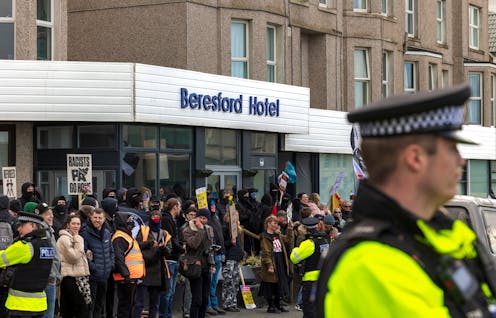
People make decisions about where to live, when to leave and where to move based on several complex factors. Among policymakers and people who study immigration, the term “push” factor is used to describe what drives people to leave a country (for example, violence, persecution or poverty).
For many years, the UK and other governments have claimed they can stop or reduce irregular migration by removing “pull” factors – those that attract people to a particular country. These might include a generous public welfare system or job opportunities.
In recent months, UK government ministers have claimed that housing asylum seekers in hotels while they await a decision on their application is one such pull factor. This is why they have introduced measures like the Bibby Stockholm accommodation barge and the threat of deporting irregular migrants to another country while their claims are processed.
Like many other countries, the UK also prevents asylum seekers from entering employment until their application is decided. The government has said that work restrictions are necessary to keep employment from being a pull factor.
But, as our research shows, there is little evidence that these policies are effective in deterring people from seeking asylum in the UK. In fact, the most important pull factors are not something the government has much control over.
Why do people migrate?
By looking at data on asylum seekers coming to EU countries between 2008 and 2020, we were able to determine what really drives people to seek asylum in particular countries.
Our results suggest that the strongest pull factor for asylum seekers to a destination is social networks, as measured in terms of previous asylum applicants, as well as numbers of previous migrants from the same origin residing in the destination. In other words, people are likely to go where others from their family or community have gone. Personal contacts can provide information to other asylum seekers about the destination country, as well as offer help on arrival.
Restricting access to the labour market or to the welfare system has only a modest impact on people’s decisions to come to a particular country and will not be effective in reducing the number of asylum applicants.
In reality, these policies lead to more vulnerability and exploitation of refugees – for example, forcing people into precarious or illegal work arrangements.
Economic factors
We also found that the number of asylum applications is not highly driven by access to employment. The generosity of the welfare system, economic factors like income level and unemployment rate, and cultural factors such as language also have modest roles.
The processing time of asylum applications and the success rate of first-time asylum applications are significant factors but not the main drivers of destination choice. The UK’s now record-high backlog of applications means people could be waiting years for a decision. However, this is not a strong deterrent, particularly if the success rate of asylum applications is high.
All of this, and plenty of other research, tells us that harsh policies preventing asylum seekers from working or accessing support, threatening deportation to Rwanda, or mishandling a backlog of applications, are not going to stop irregular migration.

The right to work
This, then, raises an important question about whether asylum seekers should be allowed to work when they reach the UK.
Only a few EU countries, including Croatia, Greece and Sweden, allow asylum seekers immediate access to the labour market. The majority of EU countries enforce a ban period that varies between two months and a year. Some countries, like Austria and Ireland, only grant access to the labour market once the asylum claim has been accepted.
In the UK, asylum seekers are not allowed to work while their application is considered, unless they have been waiting for a decision for more than 12 months.
There has been an ongoing campaign, led by the charity Refugees Action, to lift the ban on asylum seekers being allowed to work. Studies show that the employment ban has a detrimental effect on refugees’ employment opportunities in the long term.
Our findings suggest there is little evidence that employment access would act as a pull factor – not when the influence of social networks is so strong. On the contrary, the evidence shows that not allowing asylum seekers to work is a loss for the economy.
Jackline Wahba received funding from the European Union’s Horizon 2020 research and innovation programme under grant agreement No. 870299 QuantMig: Quantifying Migration Scenarios for Better Policy.
Valentina Di Iasio does not work for, consult, own shares in or receive funding from any company or organisation that would benefit from this article, and has disclosed no relevant affiliations beyond their academic appointment.
This article was originally published on The Conversation. Read the original article.







